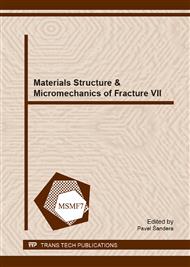p.14
p.22
p.30
p.39
p.43
p.47
p.51
p.55
p.61
Stress Analysis of Highly Constrained Copper Strips with through Crack Shaped Voids Using Molecular Dynamics
Abstract:
A small rectangular strip of fcc Cu, containing a through crack on the nanoscale and subjected to loading under displacement control, is simulated using molecular dynamics (MD). The geometry is highly constrained and chosen to mimic that of a thin strip between two stiff layers. The Lennard-Jones pair potential is used for the inter-atomic forces. The centrally placed crack shaped void is created by removing a few atoms inside the specimen. The crack is loaded perpendicular to the crack plane and the tensile stress is studied as it varies over the thickness of the strip. Comparisons with finite element calculations are made and the goal is to find a limit in model size beneath which the finite element (FE) solutions and linear elastic fracture mechanics (LEFM) lose their accuracy.
Info:
Periodical:
Pages:
43-46
Citation:
Online since:
November 2013
Authors:
Keywords:
Price:
Сopyright:
© 2014 Trans Tech Publications Ltd. All Rights Reserved
Share:
Citation:


